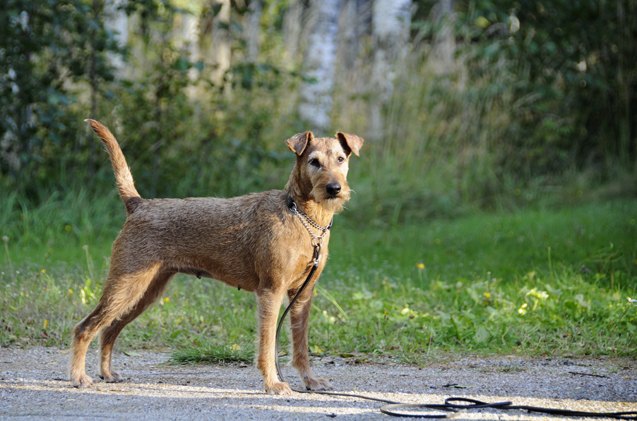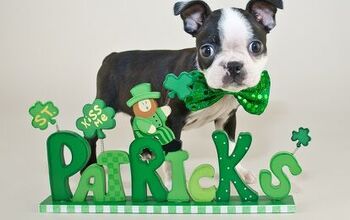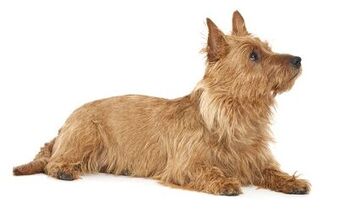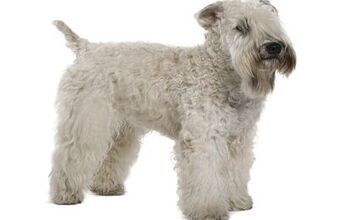Irish Terrier


About Irish Terrier
Versatility should be the middle name of the Irish Terrier. This breed is full of energy and has the courage of a lion. He doesn’t realize that he is a medium-sized dog. To him, he is the King and will take out any animal that he has not befriended. This breed will also chase anything that runs, including your neighbors and their children. A fenced yard is a must for this energetic fellow.
The Irish Terrier is playful. He will happily spend hours in the yard with your kids playing ball, hide and seek, fetch or even Frisbee. After a tough day of play, he will snuggle up to you on the couch and expect that his tummy will be rubbed until he drifts off to sleep. To learn more about the Irish Terrier, please read on.
Versatility should be the middle name of the Irish Terrier.
No one knows where the Irish Terrier originated however; it is safe to say that it is one of the oldest terrier breeds. The Irish Terrier was bred to be a versatile dog. He was meant to work on farms, hunt, guard his family and home as well as be a companion. Today, this breed is an excellent watchdog and a loving companion.
Most people believe that the Irish Terrier is a descendant of the Wirehair Black and Tan Terriers from the 1700s and larger Wheaten-colored Terrier. In 1879, two incredibly prolific champions named Ch. Erin and Ch. Killney Boy began to reproduce. These breedings resulted in numerous champion progeny. The Irish Terrier was one of the reasons that ear cropping in dogs was banned in Great Britain in 1889. You see, the Irish Terrier Club would not allow dogs with cropped ears to be shown and this controversy, led to the cruel act being abolished in the nation.
Irish Terriers use a lot of energy while playing so they need a high-quality diet of dry kibble. Dry food will help to prevent oral health problems such as tooth decay, bad breath and gum infections.
The Irish Terrier is an all-around great dog however; he can prove to be challenging when it comes to training.
The Irish Terrier is an all-around great dog however; he can prove to be challenging when it comes to training. This breed needs to be trained with consistency and plenty of treats and praise. Irish Terriers will not respond to manhandling or harsh methods. Positive training methods are essential to the dog’s success in learning.
Irish Terriers usually enjoy competing in obedience trials. Many also like agility courses too. This breed’s genuine friendliness makes them good candidates for therapy dogs.
On average, the Irish Terrier weighs between 25 and 27 pounds and stands between 18 and 20 inches tall at the withers.
Like the typical terrier, the Irish Terrier has more personality than any one dog needs. He is full of energy and loves to play. As a matter of fact, he will play with nearly anybody so long as they have a ball, toy or want to be chased. With that being said, Irish Terriers prefers human playmates to canines. He is standoffish with other dogs and can occasionally become aggressive with them. This is a breed that doesn’t back down, regardless of the other dog’s size. The Irish Terrier will do best in a home without other pets.
The Irish Terrier is a very vocal dog. He loves to hear himself bark! This can be escalated if you live in a home or area that allows for echoes. The dog would be in heaven, but you and your neighbors would be pilling your hair out. It’s best to teach the dog to quiet by command from a young age.
Irish Terriers have an incredible chase instinct. They need to be kept on a leash or inside of a securely fenced yard. If left to roam free, the Irish Terrier will chase down neighborhood pets and get into brawls. Safety is a must when living with this spunky terrier.
The Irish Terrier is one of the healthiest dog breeds. There are no known conditions or problems that are seen consistently within the breed.
The life span of the average Irish Terrier is 12 to 16 years.
Irish Terriers, although energetic, don’t need tons of exercise. A good, brisk walk each day and a trip to the dog park for rip roaring fun each week will suffice. This breed does enjoy running, so a fenced yard would surely be a plus. When not inside of a secure area, the Irish Terrier should always be kept on a leash.
His playful nature makes the Irish Terrier the perfect family companion. Children love the Irish Terriers desire and ability to catch a ball and bring it back to them. Both the dog and the kids will be tuckered out by the end of the day!
Like the typical terrier, the Irish Terrier has more personality than any one dog needs.
The American Kennel Club writes: “The Irish Terrier is a smart, quick dog that quickly adapts to new situations. He’ll guard his home and family members with determination and pluck. This breed is great with children when raised with them and is deeply loyal to his owner. Pups require firm boundaries so they will grow into respectful adults.” The Irish Terrier was first recognized by the AKC in 1885.
The dense and wiry coat of the Irish Terrier is short and crisp. The breed is dual coated so that it is protected from the elements. The undercoat is fine and soft while the outer coat is dense. The coat can be various shades of red, including bright red, golden red and wheaten red. Wheaten is also an acceptable color in the breed.
Being a hypoallergenic breed, the Irish Terrier doesn’t shed much. A weekly brushing will keep his coat clean and skin healthy. Dogs that will be shown need to have their coats hand stripped however; pets can be kept in the rough. Bathing should be done when the dog is dirty or begins to smell.
Early socialization and training is important for raising an Irish Terrier puppy to become a well-behaved companion. Puppy kindergarten classes are a good idea. This will give the pup a basis for further training as well as allow him to socialize with other animals and people.

Amy Tokic, Editor of PetGuide.com, is a passionate animal lover and proud pet parent of Oscar, a Shih Tzu/Chihuahua cross, and Zed, a Japanese Chin. Her love of animals began in kindergarten, when she brought her stuffed dog Snoopy into class with her every day. Now, she writes about her adventures in pet ownership and tirelessly researches products, news and health related issues she can share with other animal enthusiasts. In her free time, Amy loves perusing used book and record stores, obsessing over the latest pet products available and chasing squirrels with wild abandon (a habit attributed to spending too much time with her pooches).
More by Amy Tokic

























